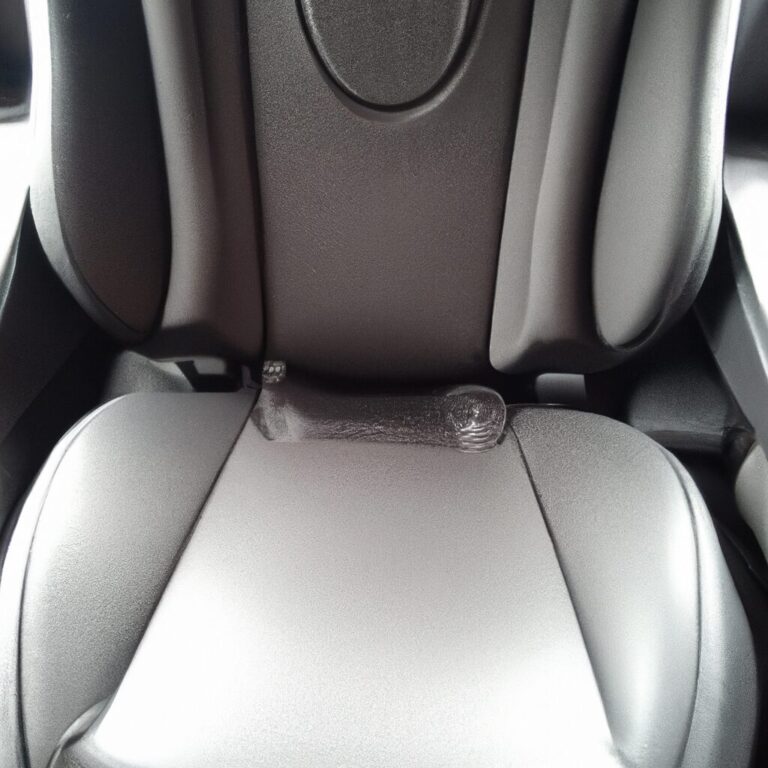How to Tell If Someone Put a Screw in Your Tire
If you suspect a screw in your tire, look for a visible screw head or mark. Discovering a foreign object like a screw in your tire can be a stressful situation.
Noticing a potential threat to your tire’s integrity can lead to concerns about safety, costs, and inconvenience. In this guide, we will explore common signs that may indicate someone has intentionally or accidentally inserted a screw into your tire. By learning how to identify these key indicators, you can take prompt action to address the issue and ensure the safety and functionality of your vehicle.
Let’s delve into the telltale signs of a screw in your tire and how to effectively deal with this situation.

Credit: www.reddit.com
Signs Of A Screw In Your Tire
If you suspect a screw in your tire, look for a noticeable hissing sound or a sudden drop in tire pressure. Additionally, examine the tire for a visible screw stuck in the tread. Moreover, pay attention to any vibrations or wobbling while driving, as they can indicate a foreign object in the tire.
Signs of a Screw in Your Tire If you suspect that there might be a screw in your tire, it’s crucial to take immediate action. Not only can a screw pose a safety hazard, but it can also lead to further damage and leave you stranded on the road. To help you identify whether there is indeed a screw in your tire, watch out for the following signs: loud noise while driving and loss of tire pressure.Loud Noise While Driving
One of the key indicators that there might be a screw in your tire is the presence of a loud noise while driving. If you notice an unusual banging, thumping, or clicking sound coming from one of your tires, it’s essential to investigate further. This noise occurs because the screw causes the tire to wobble irregularly as it rotates, creating an audible disturbance.Loss Of Tire Pressure
Another clear sign of a screw in your tire is a loss of tire pressure. If you continually find yourself having to inflate your tires more frequently than usual or if you notice a sudden drop in tire pressure, it could mean that a screw has punctured your tire. In this case, it’s vital to check your tire for any visible signs of damage, such as a nail or screw embedded in the rubber. To determine whether there is a screw in your tire, follow these steps: 1. Visually inspect the tire: Carefully examine the surface of your tire for any obvious signs of a screw or other foreign object. If you notice any abnormalities like a protruding screw head, it’s crucial to address the issue promptly. 2. Feel for air leakage: Run your hand over the tire to detect any air leakage. If you feel a stream of air or notice a hissing sound, it’s a sure indication that a screw has caused a puncture. 3. Check tire pressure regularly: Get into the habit of checking your tire pressure regularly. By doing so, you can easily identify any sudden drops that may indicate a screw puncture. Use a tire pressure gauge to ensure accurate readings. 4. Inspect the screw’s location: If you do identify a screw in your tire, take note of its location. This information will be helpful for tire repair professionals when fixing the puncture. Remember, if you suspect a screw in your tire, it’s crucial to get it repaired as soon as possible to prevent further damage and ensure your safety on the road. Don’t hesitate to seek professional assistance when needed.Credit: www.quora.com
Inspecting Your Tire
One of the key steps in determining if a screw has been lodged into your tire is through a thorough inspection of the tire’s surface. Follow these steps to visually examine your tire for any potential screws or punctures.
Visual Examination
- Look closely at the surface of the tire for any foreign objects such as screws or nails.
- Scan the tire tread for any irregularities or signs of punctures.
- Check the sidewalls of the tire for any visible damage or objects protruding.
Using A Tire Pressure Gauge
- Unscrew the valve cap from the tire valve stem.
- Attach the tire pressure gauge to the valve stem firmly.
- Read the tire pressure displayed on the gauge to ensure it matches the recommended pressure indicated on your vehicle’s manual or the tire’s sidewall.
Dealing With A Screw In Your Tire
Dealing with a screw in your tire can be a stressful situation, but it’s important to address the issue promptly to prevent further damage or accidents.
Temporary Fix With Tire Sealant
If you notice a screw in your tire, you can temporarily fix it with a tire sealant.
- Park your car in a safe location.
- Locate the screw in the tire.
- Follow the instructions on the tire sealant can.
- Inflate the tire to the recommended pressure.
Seeking Professional Help
When a screw is in your tire, it’s best to seek professional assistance to ensure proper repair.
- Contact a local tire repair shop.
- Avoid driving on a tire with a screw.
- Follow the guidance of the tire technician for repair.
Preventing Future Incidents
Once you have discovered that someone has purposely inserted a screw into your tire, it is important to take steps to prevent future incidents. By following a few simple precautions, you can reduce the risk of encountering this frustrating situation again in the future.
Regular Tire Maintenance
Regular tire maintenance is key to preventing incidents like finding screws in your tires. By taking a proactive approach, you can identify any issues before they become major problems. Here are a few maintenance tips to help you out:
- Check your tire pressure regularly using a tire pressure gauge. Maintaining the correct pressure not only improves fuel efficiency but also minimizes the risk of tire damage.
- Inspect your tires for signs of wear and tear, such as bulges, cuts, or punctures. If you notice any damage, have it repaired or replaced immediately.
- Rotate your tires regularly to ensure even wear. This can help extend their lifespan and reduce the likelihood of encountering tire-related issues.
- Keep an eye on the tread depth of your tires. Insufficient tread depth can affect traction and handling, increasing the chances of accidents.
Avoiding Construction Areas
Construction areas are notorious for being hotspots where debris, including screws, nails, and other sharp objects, can accumulate. When possible, avoid driving through construction zones to minimize the risk of picking up foreign objects in your tires. If you cannot avoid these areas, stay vigilant and drive cautiously to reduce the chances of damage.
Additionally, be aware of roads that frequently have debris due to ongoing construction or other factors. This information can be gathered through online resources, local news, or word-of-mouth. Avoiding these trouble spots can significantly decrease the likelihood of encountering screws or other hazards.
In conclusion, by incorporating regular tire maintenance and steering clear of construction areas, you can reduce the risk of someone intentionally inserting a screw into your tire. Remember, prevention is always better than dealing with the aftermath of a flat tire or unexpected roadside emergency.
Conclusion And Safety Reminder
Conclusion and Safety Reminder:
In conclusion, it’s crucial to remain vigilant and act promptly if you suspect that someone has put a screw in your tire. By taking immediate action, you can prevent potential accidents and costly damages to your vehicle.
Importance Of Prompt Action
Identifying and addressing a screw in your tire as soon as possible is essential to avoiding a potential blowout or loss of tire pressure while driving. Prompt action can help to maintain your safety on the road and prevent further damage to the tire.
Staying Vigilant
Stay aware of your surroundings and regularly inspect your tires for any signs of tampering or damage. Being vigilant can help you catch potential issues early and prevent any dangerous situations while driving.

Credit: watermegareservoirs.qa
Frequently Asked Questions For How To Tell If Someone Put A Screw In Your Tire
How Do You Know If Someone Purposely Put A Nail In Your Tire?
If you find a nail in your tire, it may have been purposely put there. Look for signs of intentional damage like multiple punctures or tire slashing. Seek professional help to assess the situation and determine the cause of the nail.
How Do You Know If Someone Tampered With Your Tire?
Inspect for cuts, punctures, or objects stuck in the tire. Check for unusual vibrations or noises while driving.
Are Screws In Tires Common?
Yes, screws in tires are common, especially in urban areas where construction sites and debris are present.
What Happens If You Drive With A Screw In Your Tire?
Driving with a screw in your tire can cause further damage like tire puncture or loss of air pressure, making it unsafe to drive. It’s best to get the screw removed and the tire inspected and repaired by a professional.
How To Check For A Screw In Your Tire?
Inspect your tire visually and feel around the tread carefully for any protruding objects.
Can A Screw Cause A Tire To Lose Air?
Yes, a screw can puncture a tire causing it to lose air gradually.
What Are The Signs Of A Screw In The Tire?
Look out for signs such as a sudden loss of pressure, a visible screw or nail, or a hissing sound from the tire.
Conclusion
Being aware of the signs of a screw in your tire can save you from potential dangers on the road. By regularly inspecting your tires for punctures, slow leaks, or tire pressure changes, you can identify any potential screws or foreign objects that may have been lodged into your tire.
Remember to take immediate action and consult a professional if you suspect any issues with your tires. Maintaining the health of your tires is crucial for a safe and smooth driving experience. Stay vigilant and stay safe on the roads!

